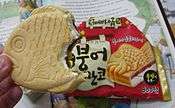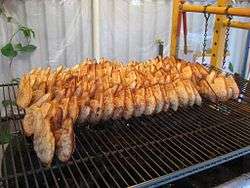Bungeoppang
|
Bungeoppang being sold in Toronto | |
| Course | Dessert |
|---|---|
| Place of origin | Korea |
| Main ingredients | Batter, red bean paste |
|
| |
| Bungeoppang | |
| Hangul | 붕어빵 or 잉어빵 (NK: 링어빵)[1] |
|---|---|
| Revised Romanization | bungeoppang / ingeoppang (NK: ringeoppang) |
| McCune–Reischauer | pungŏ ppang / ingŏ ppang (NK: ringŏ ppang) |
Bungeoppang (lit. “crucian carp cake/bread”) is the Korean name of a pastry similar to the Japanese fish-shaped pastry taiyaki.
Bungeoppangs are prepared using an appliance similar to a waffle iron. The batter is poured into a fish-shaped mold, red bean paste is added, then more batter to encase the red bean paste. The mold is then closed, and roasted.[2]
In Korean, bung'eo (붕어) means Carassius, a kind of fish, and ppang (빵) means bread. This name simply comes from the fish-like shape and appearance of the pastry, and it does not contain any ingredients from its namesake fish or any other fish.
Bungeoppang was first introduced into Korea by the Japanese during the Colonial Korea in the 1930s.[3]
In 2016, one U.S. dollar could purchase three or four bungeoppangs, depending on the location.
The vendors sell them in a similar way to Korean eomuk (어묵) or Japanese kamaboko. Hotteoks (호떡) are made and sold in a similar way to that of bungeoppang.
There are also bungeoppang-shaped waffles filled with ice cream and pat (sweetened and boiled red beans or azuki beans). These waffles are usually mass-produced and sold by retailers, not by open-air food vendors.
Similar variations also exist:
- Gukhwappang (국화빵, “chrysanthemum cake”) is essentially identical to bungeoppang, only it is a flower-shaped pastry.
- gyeranppang (계란빵, lit. “chicken egg cake”) is filled with egg and it has a shape of rounded rectangle.
Because each pastry looks exactly the same, Bungeoppang in Korean can colloquially refer to things that look identical.
 The Binggrae company offers an ice cream novelty based on bungeoppang
The Binggrae company offers an ice cream novelty based on bungeoppang
See also
References
- ↑ Martin, Samuel E. (1992). A Reference Grammar of Korean (1st ed.). Rutland and Tokyo: Charles E. Tuttle Publishing. p. 95. ISBN 0-8048-1887-8.
līnge
- ↑ Goldberg, Lina "Asia's 10 greatest street food cities" CNN Go. 23 March 2012. Retrieved 2012-04-11
- ↑ 이규연 (2003-12-13). 분수대 붕어빵 (in Korean). JoongAng Ilbo. Retrieved 2007-07-09.
